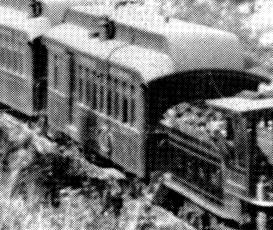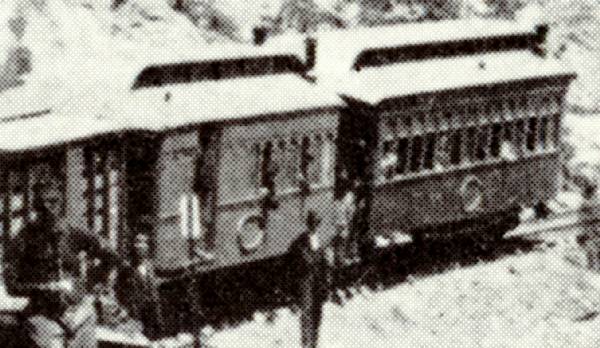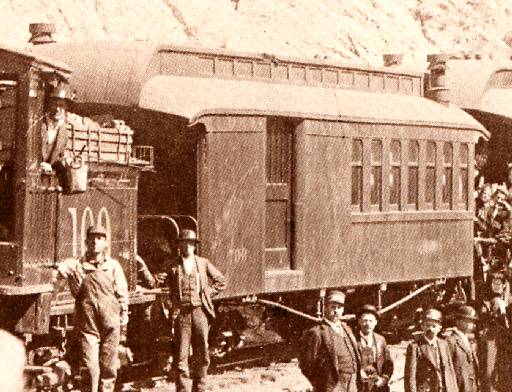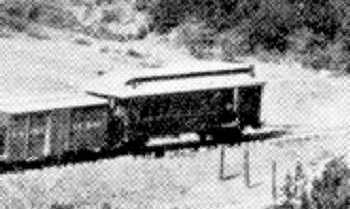Coach-Baggage #1 - Auraria
|
 |
For comparison, here's a car that has the more usual centering of the name panel between the door and the end of the car, and an arched roof apron. |
The square-topped baggage door extends up through the letter-board to the eave line. The platform roof has a hooded profile much like the later “Bowers-Dure” cars. It comes down to the eave line, and the roof apron is almost flat, rather than having an arch as on the car in the photo immediately above. In short, it looks more like an awning than the usual overhang.
Coach-baggage #1 was either painted a deep brown (some say “chocolate” brown—but with differing eye as to what constitutes “chocolate”) or stained a medium brown. Lettering was of gold leaf with “stripes and trimming.”
Only 7'-7" wide, coach-baggage #1, probably had the two-and-one seating that was common to early narrow gauge cars. We can’t know for sure, because the first record we have—the 1885 renumbering list—rates capacity by the number of seats, of which coach-baggage #1 had 10. The C&S passenger car diagrams are no help, because they show 11 seats -- with one seat space taken up by a water cooler -- and rate the car at a seating capacity of 22. Four abreast seating in a car with an interior width of 6'-11" (83") would be real cozy.
 |
|
(2) South Park coach-baggage car #1 at Buffalo Creek Station, probably during the latter half of 1878, with one of the brand-new Barney & Smith coaches. Notice the difference in width. Car #1 was 7'-7" wide, while the Barney & Smith coaches were 8'-0" wide. Also notice the difference in windows. Car #1 had single pane, downward-opening windows, while the Barney & Smith coaches had double pane, upward-opening windows. Photo by Charles Weitfle at Chappell-31, Digerness1-165 and Kindig-32. The Ted Kierscey Collection (Image 0048), online at The Narrow Gauge Circle, has a better version of this photo, where the guy sitting on top of the locomotive cab has gone elsewhere. Sorry we can’t blow it up for you: the Kierscey collection is available only at its own website. That photo also now appears at Ferrell/SoPk-31, but the reproduction is too poor to get a better blow-up. |
HISTORY
First-class coach-baggage car #1 was built by Hallack & Bro. Lumber Company, to whom the South Park had let contracts for its first freight cars. The Denver Daily Times of March 18, 1874 reported the railroad had contracted with Halleck for construction of 40 freight cars, one first class passenger car, and one first class baggage car. {36}
Hallack & Brother was a lumber, millwork and hardware firm, with no experience at building anything. Why did they get the contract? Perhaps it had something to do with the brothers being major stockholders in the South Park. (Poor shows E.F. Hallack as a Director of the Corporation in 1879.{34})
The railroad’s annual report for 1874 says: {35}
|
“... it has been the policy of the company in every practicable way to encourage home industry. With this in view they have had all their cars manufactured in Denver. And it is safe to say that no better freight cars or more elegant passenger cars are to be found than those made for your road, by Messrs. Halleck Bros. of Denver.” |
But in fact, the early cars Hallack built (freight as well as passenger cars) were probably constructed from assemblies obtained from eastern car builders. Most car builders of the time built cars in pieces that could be conveniently shipped either overseas or domestically, and assembled on-site. Jackson & Sharp was one of these, and some believe they supplied the parts for the cars built by Hallack. Ron Rudnick reports finding a South Park Journal entry dated 15 October 1874 recording payment to Jackson & Sharp for several car parts {8} and notes the passenger car in photo #2 resembles the cars Jackson & Sharp built for the Rio Grande. It is also possible the assemblies were produced by Barney & Smith, as the South Park turned to them for their next major order of freight and passenger cars (1878).
Coach-baggage #1 was delivered to the South Park 7 July 1874, just one week after the Morrison line was officially opened, and was immediately pressed into service. For the next four years it was the only coach-baggage car owned by the South Park. In fact, it and coach #2 were the railroad's only passenger cars until May of 1878.
Several sources say coach-baggage car #1 was built in 1880 by the South Park. This information is based on the C&S passenger car diagram for C&S #22, which is obviously wrong. But then the purpose of these documents was not to be historically correct, but was to tell the engineering department how big each car was, how heavy, how many passengers could be carried, and other such mechanical information. Incidentally, coach-baggage #1 is the only car so attributed to the South Park.
Like most passenger cars of the time, coach-baggage #1 was given a name as well as a number. The South Park’s practice was to name cars for towns along the line or which they hoped to eventually reach. This very first car was named Auraria after Denver’s “twin city” on the west bank of Cherry Creek that eventually became the west side of Denver. (Not to be confused with Aurora, a modern-day eastern suburb.) It is perhaps appropriate that this first passenger car was named after the first “city” to be platted at the confluence of Cherry Creek and the South Platte River.
In 1885, at the Union Pacific renumbering, Auraria was renumbered #700, a number befitting its identity as a combination coach-baggage car in the U.P. numbering scheme. It kept that number after 1889 when the railroad became the Denver, Leadville and Gunnison.
During the 20 years between its construction and the 1898 date of the next photo, coach-baggage #700 was rebuilt in a number of ways, not necessarily at the same time. But it kept its characteristic flat-topped, roof-high baggage door and its end platforms at both ends.
| 1. | Its exterior was resheathed. (Someone has noted that wood from the more humid eastern states—particularly if not well-seasoned—rapidly dried out in the Colorado mountains and soon left gaps between the boards.) There is no trace of the former filled-in windows, the oval name panel is gone, and the belt rail that ran the length of the car—and did so much to give the car that coach-with-a-baggage-door look—now ends with the window nearest the baggage door. | |
| 2. | The arched, downward-opening single-pane windows were replaced with more passenger-friendly, squared-off, upward-opening double-pane windows (think about it). | |
| 3. | The platform roofs were rebuilt from the broken-bullnose profile to the more modern bullnose configuration. |
 |
(3) Denver, Leadville & Gunnison #700 at Roscoe on the Colorado Central, 1898. Harry Buckwalter photo at Digerness3-339, Hauck-98(u), Poor-280(u)(ME) and Mangan-346. |
